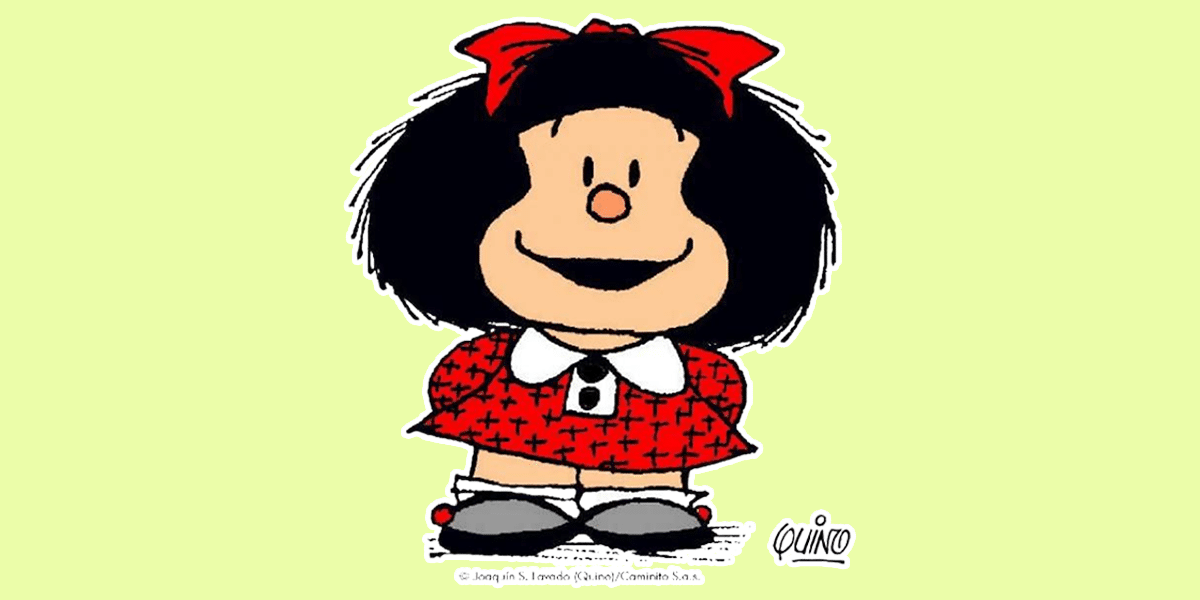¡Paren el mundo que me quiero bajar! says Mafalda in one of her famous cartoons. Sixty years and some 1900 newspaper strips later, the Mafaldamania is still going strong and continues to be a lucid and scathing reading of reality. From cartoonist Joaquín Salvador Lavado (Mendoza, 1932-2020), better known by his pseudonym Quino, the masterpiece turned 60 recently and has lost none of its original wit.
Quino’s Mafalda offers a portrait of a middle-class Argentine family and focuses on the tribulations of the gifted and precocious firstborn daughter, capable of unraveling the complexity of the world from her childish soul. Extremely perceptive and nonconformist, “la nena” devours the newspaper and longs to be part of the UN. Little could Quino suspect that this rebellious creature would captivate the public’s imagination in a perennial and extraordinary way.
Although Mafalda made her appearance for an advertising assignment in 1962, her official birth dates back to September 29, 1964, in Primera Plana magazine. Her success was immediate, transcending geographical boundaries and winning over a devastatingly loyal readership. Since then and to this day, Mafalda’s sharp observations, both on the Argentine political scene and on internationally – commenting on the Vietnam War, education, the role of women in society, even the meaning of life – continue to be reproduced around the world. It was not in vain that Umberto Eco, dubbed her the “heroine of our time.”
More than half a century later, Mafalda remains in bookstores across the globe, circulates through social media, has monuments and squares, and continues to be an icon of critical thinking. As part of a new anniversary, let’s review some amazing facts about Mafalda and its illustrator.
Mafalda Began as a Way to Advertise Household Appliances
The original idea for Mafalda, the girl who hates soup and contradicts the evils of the world, arose in 1963 when the humorist Miguel Brascó involved Quino in an advertising project for the household appliances brand Mansfield of the Siam Di Tella company. “In reality, Mafalda was a commission, it was not that I thought of doing this family,” the Argentine cartoonist told El País.
At that time, Brascó introduced Quino to the agency Agens Publicidad, which was in search of an experienced cartoonist. At the request of the advertisers, the cartoon had to cross the style of Peanuts with that of Blondie, and in addition, the names of the characters had to begin with the letter “M,” to match the initial of “Mansfield.” In the end, the advertising project came to nothing, but Mafalda came to life.
A year later, in September 1964, Julián Delgado, director of Primera Plana, commissioned Quino to create a cartoon for the popular magazine. It was then that the artist rescued the Mafalda strips from oblivion and the rest is history. Since her first appearance, the little girl with black hair and a red bow has been translated into more than 25 languages, including Braille, and reached countless homes. It is even available on iPad and Kindle and has official social media accounts.
Much More Than a Comic Character
More than a comic strip character, Mafalda is now a Latin American icon, deeply admired and unreservedly loved. In the 60 years since its appearance, the comic strip has stood the test of time and become a symbol of cultural identity and social criticism. Despite lasting less than a decade in the print media (1964 – 1973), Quino’s Mafalda has become woven into our voices, our senses, and our sensibilities as expressed by Gabo and Julio Cortazar.
Although Mafalda’s adventures officially ended on June 25, 1973 in Siete Días Ilustrados, the character was able to maintain an existence of her own without too much effort. In the following years, Quino brings her back to collaborate with charitable causes and campaigns, partnering with organizations like UNICEF, the League for World Health, the Ministry of Foreign Affairs of Argentina, and the Spanish Red Cross.
Always concerned about humanity and its future, Mafalda continues to move, inspire, amuse, and make her readers think. It is fair to say that we are indebted to Mafalda, her friends, and the Bureaucracy turtle.
The House of Mafalda Exists
Addicted to the Beatles, Mafalda has her home in the Buenos Aires neighborhood of San Telmo, near Chile 371. It was there, in that old and central neighborhood where the cartoonist lived in the 60’s, and it was there where he created her and saw her grow up. “Mafalda was from this neighborhood and not only Mafalda, I got the Don Manolo store from a nearby bakery,” Quino told La Nación.
Since the author had transferred the urban landscape of San Telmo to his story, the government of the City of Buenos Aires decided in 2009 to install a commemorative plaque right at the entrance of his building. “Here lived Mafalda, famous character and Cultural Heritage of the City,” reads the announcement. As part of the same tribute, they inaugurated a life-size statue of Mafalda, a few meters away from Quino’s apartment.
Mafalda is Coming to Netflix
Mafalda fans: Netflix has confirmed that it is preparing a new animated series about the iconic character. Oscar-winning Argentine Juan José Campanella, a staunch admirer of the cartoon, will be the director, screenwriter, and showrunner of this audiovisual adaptation. “Without a doubt, and by far the biggest challenge of my life,” said Campanella in an official statement. We can’t wait to watch!

